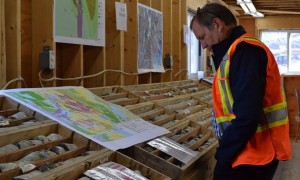
Mr. Quartermain was the founder of Silver Standard and grew that company from $2 million to $1.9 billion (Photo: Pretium Resources Inc.)
As of today, the non-believers of Robert Quartermain's Brucejack project have been proven wrong.
Pretium Resources (PVG:TSX), which is developing the Brucejack project, released an updated feasibility study on the project late yesterday which showed strong economics and viability even at low gold prices. Since their last feasibility study in mid-2013, the company drilled underground in greater density trying to understand the complex geology better in order to show that mining the super high-grade, but narrow veins would be economic.
Importantly, the updated study shows increased average mineable grades, from 12g/t gold life-of-mine (LOM) to 14.1g/t gold (an increase of 18%).
The updated feasibility study uses $1,100/oz gold and $17/oz silver in its base case which arrives at a post-tax NPV(5%) $1.45 billion and IRR of 28.5%, with the expected ability to payback invested capital after 2.8 years. The 2013 feasibility study used $1,350/oz gold and $20/oz silver which showed a $1.76 billion post-tax NPV(5%) and 35.7% IRR.
The company decreased the mine life to 18 years (from 22 years), but kept the throughput consistent at 2.700tpd and also increased the total mined ounces to 7.26 million from 7.1 million.
Average annual production increased to 404,000 ounces from 321,500 ounces LOM.
"Brucejack will be a high-grade, low-cost producer with average annual production of over 500,000 ounces of gold in the first eight years," said President and CEO Robert Quartermain. "Even in an uncertain gold price environment, Brucejack can deliver high margins, and from a safe jurisdiction."
Total capex increased from $663 million to $747 million which the company attributes mainly to power, camp size, temporary facilities, water and sewerage treatment, waste disposal, and owner's costs. Opex increased marginally as well (from $156.46 to $163.05/t milled), however margins remained high.
Of importance, the study showed, even at $800/oz gold that the project remains economically viable with a $620 million post-tax NPV(5%), 16.5% IRR and 4.4 year payback period.
Despite the bumpy ride investors have had with this story over the past year, this updated feasibility study should prove to investors that this project is real and that the grades indicated in the resource estimates are consistent with those that will be mined. In terms of size and grade, Brucejack remains one of the best projects on the market today.
Here's the long-term chart:
Now that Pretium's management feels confident in the project's economics, they now turn to the permitting phase. The timeline for this is as follows:
- File its Environmental Assessment Certificate application (EAC) with BC officials (end of June/14)
- EAC reviewed for completeness (30 days - end of July/14)
- File Environmental Impact Statement (EIS) with Federal authorities (July/14)
- BC authorities review merits and prepare assessment report. Similar timeframe for EIS (180 days - end of Q4/14)
In the province of BC, both the Federal and Provincial environmental permits are required for the construction and development of a project.
In the release, Pretium's management also indicated they would begin evaluating financing options for the robust project in Q3/14 with the anticipated start of commercial production in 2017 (a pushback from the previously thought 2016 start-date).
The company had $28 million in cash as of March 31st.
Read: Updated Feasibility Study for Brucejack Project Confirms Positive Economics























